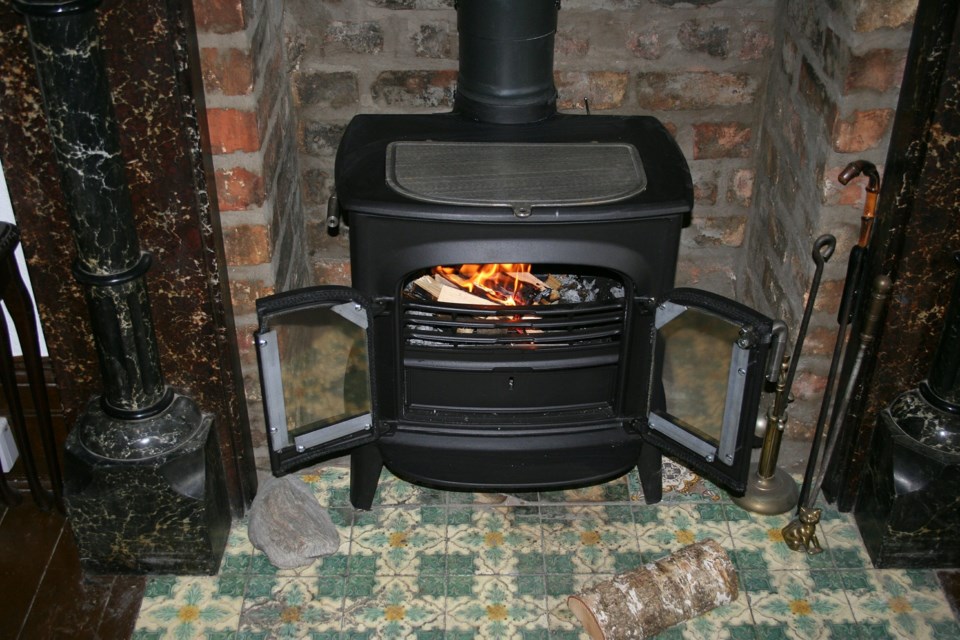This informational column was submitted to PrinceGeorgeMatters from Lindsay Sackett, Northern and Interior Region Program Coordinator for the Prince George Air Improvement Roundtable (PGAIR).
For many northern B.C. residents, burning wood is a part of daily life during cold months.
The smell of burning wood brings on nostalgic feelings for many, reminding us of campfires, warmth, and good times shared with loved ones.
Although wood-burning has been an essential part of human survival for millennia, exposure to wood smoke can also negatively impact our health.
Wood smoke is made up of a complex mixture of gases and very fine particles, known as fine particulate matter, or PM2.5. These particles are extremely small, a tiny fraction of the width of a human hair.
Because of its small size, when PM2.5 is inhaled, (if you can smell wood smoke, you are inhaling it), it travels deep into your lungs, into your tissue and blood stream, where it causes inflammation and disease.
Although wood smoke is “natural” it contains several toxic chemicals in addition to PM2.5.
These chemicals include benzene, formaldehyde, acrolein, and polycyclic aromatic hydrocarbons (PAHs), and short-term exposure to them can aggravate asthma and lung disease, and increase your risk of acute lung infections such as bronchitis.
Much like cigarette smoke, long-term exposure can cause chronic obstructive pulmonary disease (COPD), chronic bronchitis, cardio-vascular disease, and even lung cancer in vulnerable populations already predisposed to these conditions.
How are we exposed to wood smoke?
Although there are many sources of air pollution, some of which residents have no control over, wood smoke is uniquely harmful.
To understand how, we can refer to what is called the ‘intake fraction’ of wood smoke.
Intake fraction describes the amount of a pollutant (from a particular source) that is inhaled relative to the total amount of pollutant released.
Smoke from residential wood burning has a particularly high intake fraction, which means that relative to other sources of air pollution, people are more likely to be exposed to and inhale larger proportions of it when it is emitted.
This can be attributed to many factors, including:
- Smoke from residential chimneys is emitted relatively close to the ground
- Smoke tends to linger near the ground, as chimney smoke is often not hot enough to plume up and disperse into the atmosphere
- This effect is heightened on cold, stagnant winter days
- People are usually home during peak burning hours, meaning they are more likely to be exposed to smoke emitted around them
- Even when vented outdoors, wood smoke can travel indoors and affect indoor air as well
Long story short, wood smoke has a disproportionately high impact on human health relative to the amount that is actually emitted into the Prince George airshed.
How does wood smoke exposure affect COVID-19?
Wood smoke affects COVID-19 results on both an individual and a community level.
On an individual level, exposure to air pollution (which includes wood smoke) can irritate the lungs, cause inflammation, and alter immune function, making it more difficult to fight respiratory infections such as COVID-19, and making it easier to contract them.
If you do contract COVID-19, having a pre-existing heart or lung disease, which may be worsened by exposure to wood smoke, compounds the effects of COVID-19 causing more severe symptoms.
Those who have contracted COVID-19 and are currently or recently recovered, should take extra care to avoid direct wood smoke exposure.
These individuals may be at an increased risk of other exposure related health effects, due to compromised heart and/or lung function from enduring the COVID-19 virus.
In a northern community where there are many folks who burn wood for heat, it is important for Prince George residents to consider the community level affects that wood smoke may have on COVID-19 outcomes.
It is commonly agreed upon by health science professionals that community exposure to air pollution increases the number and severity of COVID cases in that community. In fact, a Harvard University study has shown that only small differences in pollution levels are linked to significantly higher levels of COVID-19.
It gets even more serious when we consider that about 11 per cent of worldwide COVID deaths are thought to be attributed to damage to the heart and lungs caused by breathing dirty air!
What can you do to protect yourself?
Burning wood is a life staple for many, especially in northern B.C.
Although we can’t control or avoid all sources of air pollution, it is up to us to limit our individual and community exposure to wood smoke by taking steps to minimize how much is emitted when we burn wood:
- Burn only dry, seasoned, and untreated wood by following the ‘Split, Stack, Cover, and Store’ method
- Test your wood’s moisture levels prior to burning with a moisture meter with ideal levels are 20 per cent moisture or less.
- Don’t have one? Contact PGAIR to get one!
- Regularly check the AQHI reading for your area or keep up to date on local fine particulate matter concentrations, and be sure not to burn during an air quality advisory
- Minimize the use of your wood stove on milder days – why not bundle up and make a hot drink?
- Switch out your old wood stove to an EPA certified wood stove, a pellet stove, or a gas stove
- Want some help with that? Check out the Wood Stove Exchange Program!
- Prevention is always the best policy, but if you are particularly sensitive to wood smoke (or wildfire smoke), consider purchasing a portable indoor air cleaner with a HEPA filter to minimize your exposure indoors
Following the steps above will help you burn more efficiently.
Remember, the more efficiently you burn wood, the less smoke is created, and therefore, the less PM2.5 and other toxic substances you and your neighbours will be exposed to.
Stay healthy everyone!





